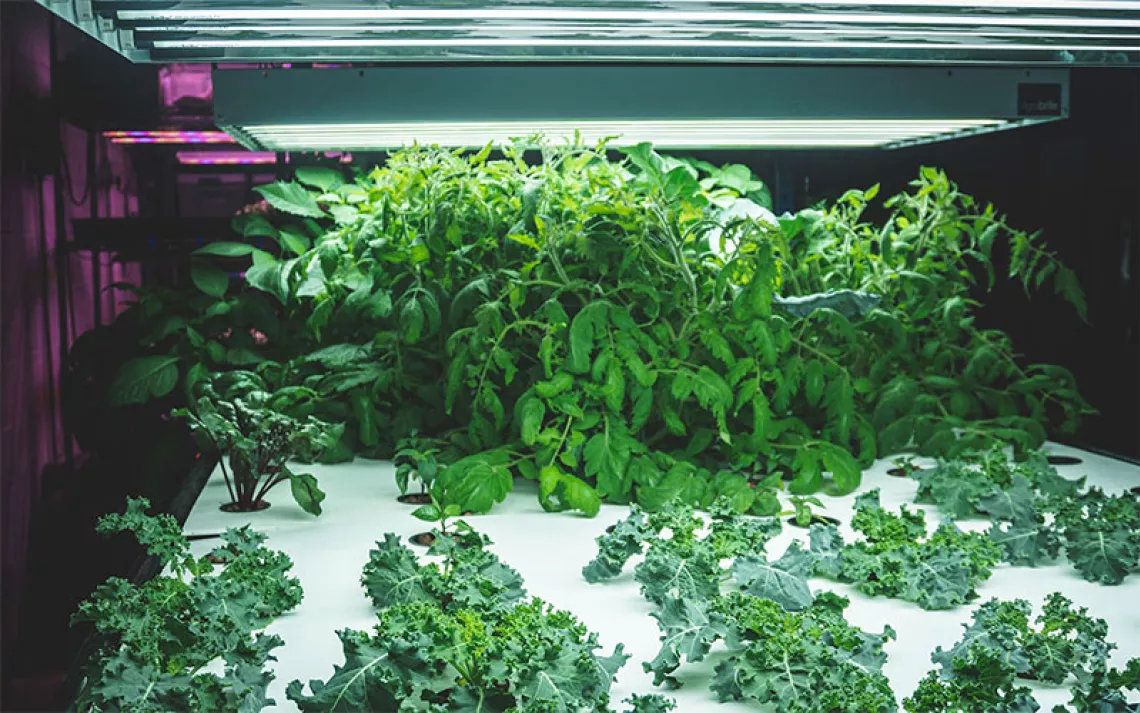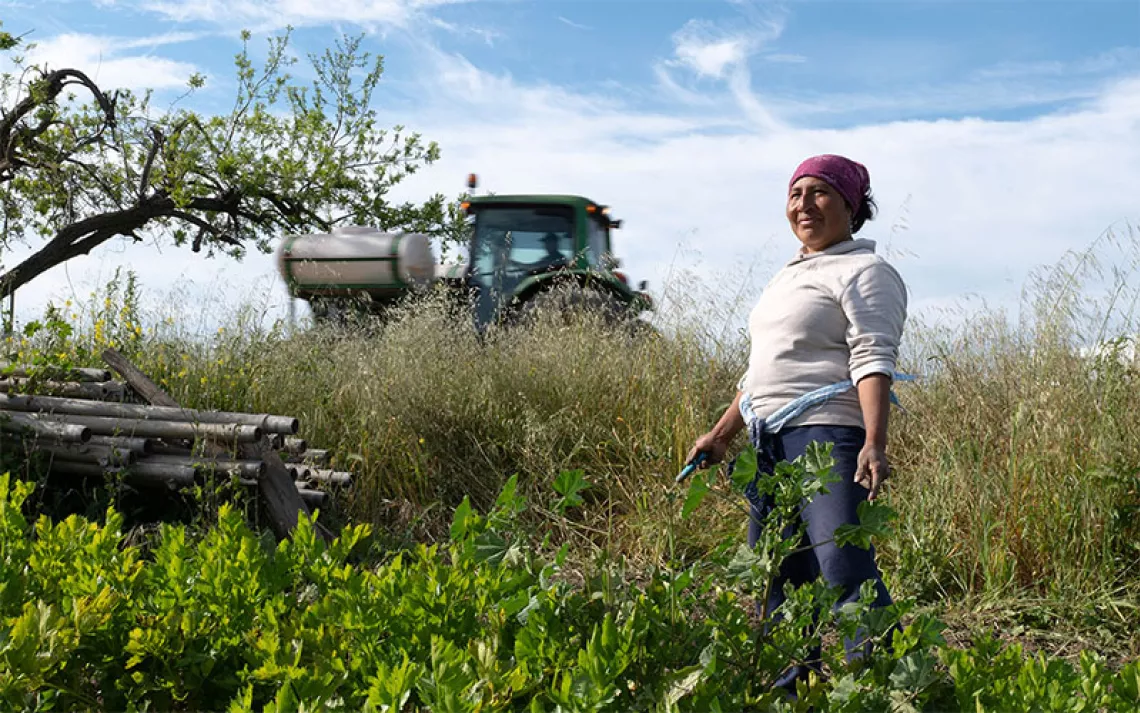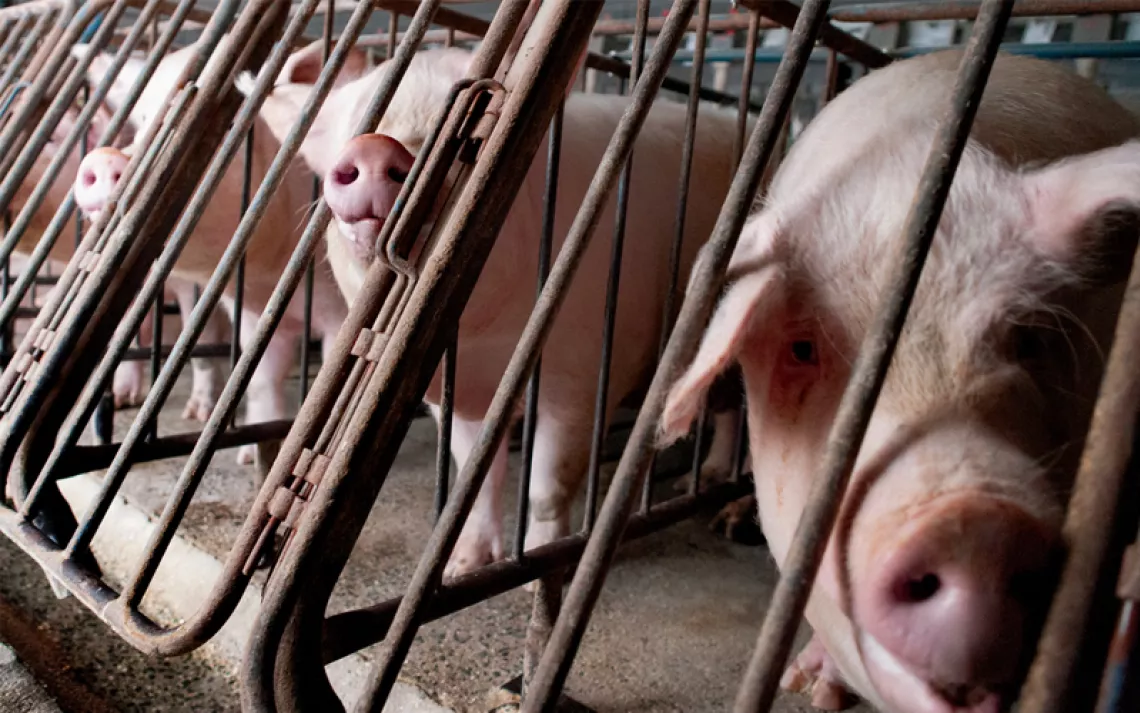Sowing Technology
The ecological argument against genetic engineering down on the farm

Drive the Nebraskan backroads in July and you will encounter one of the great technological wonders of the modern world: thousands of acres of corn extending to the vanishing point in all directions across the table-flat landscape. It appears as lush and perfect a stand of vegetation as you will find anywhere on Earth--almost every plant, millions of them, the same height, the same deep shade of green, free of blemish, emerging straight and strong from clean, weed-free soil, with every cell of every plant bearing genetically engineered doom for the over-adventurous worm.
The sophisticated tools and techniques behind this achievement inspire the same awe that seizes so many people when they see a jet airliner taking off. And yet, the question is whether this remarkable cornucopia really represents true health and bounty.
Nature manifests itself ecologically--contextually--and the whole point of today’s advanced crop production is to uproot the plant from anything like a natural, ecological setting. The latest technology delivers, along with the seed, an entire artificial production environment designed to render the crop independent of local conditions. Commercial fertilizer substitutes for the natural fertility of the soil. Insecticides prevent undesirable contact with local insects. Herbicides discourage social mixing with unsavory elements in the local plant population. And the crop itself is bred to be less sensitive to the local light rhythm.
Modern agribusiness is run more and more like a self-contained factory. And the trend toward vast monocultures--where entire ecologies of interrelated organisms are stripped down to a few, discrete elements--has become more radical step by step: first a single crop replacing a diversity of crops; then a single variety replacing a diversity of varieties; and now, monocultures erected upon single, genetically engineered traits.
As the whole process drives relentlessly forward, the organism itself becomes the denatured field in which genes are moved to and fro. Want to make a tobacco plant glow in the dark? Easy--inject a firefly gene. Want a frost-resistant strawberry? Try a gene or two from a cold-water flounder.
Despite such freakish prodigies, the overriding question about biotechnology is not whether we are for or against this or that technical achievement, but whether the debate will be carried out in such fragmented terms. In focusing on technological wonders to improve agriculture, are we losing sight of the things that matter most, the diverse and complex communities and habitats we live in? An answer requires, first, an understanding of what biotechnology is all about.
Old Science, New Extremes
Genetic engineers often argue that in altering the genetic traits of various organisms, they are only doing what plant and animal breeders have always done. As the president of the Biotechnology Industry Organization, Carl Feldbaum, put it in the New York Times: “Archaeologists have documented 12,000 years of agriculture throughout which farmers have genetically altered crops by selecting certain seeds from one harvest and using them to plant the next. It is only in the past 30 years that we have become able to do it through biotechnology at high levels of predictability, precision, and safety.”
But the concern about genetic engineering isn’t that it enables us to commit altogether new mistakes; it’s that it perfects our ability to commit old ones. No one is suggesting that the abuse of our technical powers began with the discovery of the double helix. Using conventional techniques, breeders have, for example, produced Belgian cattle with such overgrown muscles that they must be delivered by cesarean section. Likewise, there are hobbyist chicken breeders who--to judge from the pictures in their magazines--are mostly interested in bizarre effects. The difference with genetic engineering is that we can now manipulate living organisms much more efficiently--and much more casually--than ever before. Today’s technician need scarcely be distracted by the animal itself.
What is unprecedented about genetic engineering is that it selects isolated genes, not entire healthy organisms as in traditional breeding. Writing in Science, geneticist Jon Gordon assesses the failed attempts to create heavier farm animals by inserting appropriate genes. In pigs, the addition of growth-hormone-producing genes did not result in greater growth, but unexpectedly lower body-fat levels. In cattle, a gene introduced to increase muscle mass succeeded initially, but the growth was quickly followed by muscle degeneration and wasting. Unable to stand up, the experimental animals had to be killed.
Such results are hardly surprising when you consider the isolated and arbitrary intrusion represented by single-gene changes. By contrast, traditional breeding allows everything within the organism to change together in a coordinated way. With conventional methods, Gordon writes, “Swine selected for rapid growth may consume more food, produce more growth hormone, respond more briskly to endogenous growth hormone, divert proteins toward somatic growth, and possess skeletal anatomy that allows the animal to tolerate increased weight. Dozens or perhaps hundreds of genes may influence these traits.”
The logic of ecological relationships says, “Change one thing and you change everything.” The same applies to the interior ecology of the organism. Responsible traditional breeding is a way of letting everything change without violating the whole--because it is the organism as a coherent and healthy whole that manages the change.
In traditional breeding the integrity of the organisms themselves places limits upon what can be done. No amount of coaxing could get a flounder to mate with a strawberry to produce berries with “anti-freeze” genes. Now we can break through these limits, but we have not replaced the safeguard they represented. Such a safeguard can come only from our own intimate and respectful understanding of the organism as a whole and of the ecological setting in which it exists.
Unfortunately, gaining this kind of insight is a phenomenally difficult challenge. You have to see a plant or animal in its own right and in its natural environment to begin grasping what it is. But given what some ecologists have called the “demise of natural history” in our time, there is not much hope of greater familiarity with the organisms whose natures we manipulate--certainly not by those laboratory-bound researchers who are doing the manipulating. Instead of a coherent whole expressing an organic unity through every aspect of its being, the engineers hand us a bag of separate traits.
Approved, but Not Tested
Only such a fragmenting mentality could suggest (in the words of former U.S. secretary of agriculture Dan Glickman) that “test after rigorous scientific test has proven [genetically engineered] products to be safe.” The application to cows of bovine growth hormone (rBGH) produced by genetically engineered bacteria was approved primarily on the basis of tests with rats--not cows, and not people who consume dairy products. “Bt” corn, altered to contain a pesticide produced by the bacterium Bacillus thuringiensis in every part of the plant, was approved without being tested for its effects on beneficial species such as the green lacewing, or on “incidental” species such as the monarch butterfly. Subsequent research has suggested the possibility of harm to both insects.
The assimilation of foreign DNA alters organisms in consistently unpredictable ways. Only about 1 percent of genetic transfers yield the looked-for result; the other 99 percent are all over the map. For example, when scientists engineered tomatoes for increased carotene production, they indeed got some plants with more carotene--but those plants were unexpectedly dwarfed. So even the 1 percent statistic paints too optimistic a picture. This “success” rate reflects a focus on the particular trait that was desired; but even when this trait is obtained, what about the subtle changes throughout the rest of the organism? If there can be immediately obvious changes such as dwarfing, there can be many less obvious ones as well. It’s hard to test for changes when anything can happen and you don’t know what you’re looking for. In actual practice, almost no such testing is done.
Great Green Hoax?
“Crops with built-in pest resistance via modern biotechnology greatly reduce the need for pesticides,” enthused the secretary general of the Organization for Economic Cooperation and Development, Donald Johnston, in 1999. If there’s any claim that must be evaluated ecologically, it’s biotech companies’ promotion of genetically altered crops as the Great Green Hope of the environment. This assertion is puzzling at best. After all, the entire thrust of the factory-farmed monocultures encouraged by these companies is to eliminate across huge acreages all traces of any environmental richness that might have been worth preserving in the first place. And now the corporate research laboratories are poised to release into this devastated landscape a continuing stream of alien genes. Chemical spills can eventually be cleaned up, but there is no recalling the replicating genes we have loosed upon the natural world.
Perhaps the most compelling argument for environmental benefit is made on behalf of Bt cotton. The relatively mild Bt toxin is a naturally occurring pesticide. When genetically engineered into cotton, Bt is highly effective against the bollworm and substitutes for an extraordinarily nasty series of chemical sprayings in conventional cotton fields. Yet to leave the matter there is to accept the high-tech approach as the only alternative. It is also, as Charles Benbrook points out, extremely irresponsible.
Benbrook is the former executive director of the National Academy of Sciences Board on Agriculture and Natural Resources and now an agricultural consultant in Sandpoint, Idaho. He sees Bt, in its normal, externally applied form, as one of the most valuable pesticides ever developed. It is approved for organic as well as conventional use, and it keeps in check many serious pests not otherwise easily controlled. He calls it a “public good,” but suggests that engineering it on a massive scale into crops like cotton and corn is the moral equivalent of loading everyone’s toothpaste with antibiotics. Yes, the antibiotics would yield an immediate “benefit” in terms of reduced incidence of certain diseases. But the consequences for both immediate and long-term health would be ugly indeed, as disease microbes would develop resistance much more rapidly. In the case of Bt, the inevitable development of resistance by pests will reduce the useful lifetime of this pesticide to a small fraction of what it would otherwise be.
The farmer who plants Bt corn, for example, essentially commits to round-the-clock, season-long application of a pesticide in his fields before he knows whether the European corn borer will even be a problem. Benbrook estimates that up to 10,000 times as much Bt toxin is produced in the crop as would have been used in typical external applications--and that’s assuming a year in which the corn borer needed to be controlled at all. In major parts of the Corn Belt, during most seasons, it will not. In the case of Bt corn, genetic engineering prevents the farmer from exercising skilled judgment based on the ecological realities of the local environment.
Moreover, researchers have recently discovered that the Bt toxin released by the crop into the soil binds to soil particles and is then highly resistant to biodegradation. The implications for beneficial soil organisms are almost completely unknown--although the researchers found that a high percentage (90 to 95 percent) of insect larvae exposed to the toxin-tainted soil died. Crops genetically modified for resistance to herbicides pose similar problems. Knowing that crops will more or less tolerate an herbicide, farmers are likely to increase their applications. Monsanto has requested and received from the EPA a tripling of the allowance for glyphosate residue on harvested crops. (Glyphosate is the active ingredient in the company’s herbicide Roundup.) The increased residues are hardly an environmental improvement, especially in light of the fact that glyphosate has been linked to non-Hodgkin’s lymphoma, a cancer of white blood cells.
The vast expansion of acreage in herbicide-resistant crops has led to huge increases in the use of glyphosate--a 72 percent increase in 1997 alone, according to the USDA. This large-scale adoption of single-pronged weed-control strategies is deeply troubling because it encourages herbicide-resistance in weeds (already observed with glyphosate) and wholesale shifts in weed populations. These shifts require additional herbicides, and the resulting treadmill, says Benbrook, “is on hyperdrive today. We’ll burn up the current generation of herbicides in five, ten, or fifteen years instead of three to five decades.”
One sure way off this treadmill is to turn our attention toward ecological integrity. Mary-Howell Martens, who was formerly a genetic engineer and conventional farmer, now farms 1,100 acres organically in New York. Like many other organic growers, she and her husband, Klaas, grow soybeans without using herbicides. They work instead with nature, relying on soil fertility (the calcium-magnesium ratio in particular affects weed vigor); long, diverse rotations, including corn, soybeans, clover, and grains, to disrupt weed cycles; well-timed tillage early on, so that the crop gets ahead of the weeds and tends to smother them; and avoidance of high-salt fertilizers, since salt compounds stimulate weed growth. Later weed control can be done mechanically, on a spot basis, as needed.
Harnessing Complexity
Another example of ecological sophistication is integrated pest management. The technique is founded on decades of painstaking investigation into the complex and subtle weave of natural ecologies. Where the main trend of today’s biotech agriculture is to isolate the farm from its environment, reducing the operation to the simplistic terms of a few manageable variables, integrated pest management at its best tries to work with the environment.
It’s one thing to heavy-handedly engineer a pesticide into every cell of a crop; it’s quite another to manage the ecological interrelationships of the farm so that the offending insect is controlled by the natural balances. Working with this natural complexity rather than against it is also the aim of a remarkable research group in Kenya, the International Centre of Insect Physiology and Ecology (ICIPE). The organization brings together molecular biologists, entomologists, behavioral scientists, and farmers in an interdisciplinary effort to control the various threats to African crops.
The most important threats to corn and sorghum on that continent are the stemborer and striga (witchweed), which together can easily destroy an entire crop. Researchers at ICIPE developed a “push-pull” system: Grasses planted outside the cornfield attract the stemborer; a legume or grass planted within the cornfield repels the insect and also suppresses witchweed by a factor of 40 compared to a corn monocrop--all while adding nitrogen to the soil and preventing erosion; and, finally, an introduced parasite radically reduces the stemborer population.
The ICIPE’s director, Hans Herren, won the World Food Prize in 1995 after his organization gained control over the mealybug that threatened the cassava crop, a staple for 300 million people. (A small, parasitic wasp was instrumental in the success.) No chemical applications and no costs to the farmers were involved. Yet Herren doubts he could obtain funding for such a project now. “Today, all funds go into biotechnology and genetic engineering,” he laments. Biological pest control “is not as spectacular, not as sexy.”
Fortunately, some work on integrated pest management continues. In what the New York Times called “a stunning new result” from a vast Chinese agricultural experiment, tens of thousands of rice farmers in Yunnan province “have doubled the yields of their most valuable crop and nearly eliminated its most devastating disease--without using chemical treatments or spending a single extra penny.”
The farmers, guided by an international team of scientists, merely interplanted two varieties of rice in their paddies instead of one. This simple step toward biodiversity led to a drastic reduction of rice blast, currently considered the biggest threat to the world’s most important staple. The fungicides previously used to fight rice blast were no longer needed after just two years.
The experiment, covering 100,000 acres, “is a calculated reversal of the extreme monoculture that is spreading throughout agriculture, pushed by new developments in plant genetics,” observed Martin S. Wolfe in an August 17, 2000, commentary in Nature. The problem, Wolfe suggests, is that monocultures provide a kind of toxic boot camp for the development of superpests. The conventional solution--to breed resistant varieties and develop new fungicides--leads to rapid pest resistance. “Continual replacement of crops and fungicides is possible,” he says, “but only at considerable cost to farmer, consumer, and environment.”
These costs make the virtues of the new rice system all the more dramatic. How was rice blast overcome? Researchers, Wolfe says, have identified several factors. To begin with, a more disease-resistant crop, interplanted with a less resistant crop, can act as a physical barrier to the spread of disease spores. Second, when you have more than one crop variety, you also have a more balanced array of beneficial and potentially harmful pests that hold each other in check. A single pathogen, such as the one in rice blast, is therefore less likely to gain the upper hand.
Of the two varieties of rice used in the Chinese experiment, the taller one was the one more susceptible to blast. But when planted in alternating rows with the shorter variety, the taller rice enjoyed sunnier, warmer, and drier conditions, which appeared to inhibit the fungus. Finally, a kind of immunization occurs when crops are exposed to a diversity of pathogens. Upon being attacked by a less virulent pathogen, a plant’s immune system is stimulated; it can then resist even a pathogen that it would “normally” (that is, in a monoculture) succumb to.
Disease susceptibility is not simply a fixed genetic trait, but is related to growing conditions. Many existing susceptibilities reflect a crop’s extreme isolation from anything like a natural environment, with its checks and balances. This environment includes not only other plants, but also the complex, teeming life of the soil--life that is badly compromised by “efficient” applications of fertilizers, herbicides, and pesticides. And, as these new findings indicate, even a “healthy” variety of disease organisms is important. What biotech company, focused on the latest, profit-promising lethal gene, would encourage such a balanced awareness among farmers?
The Real Future of Agriculture
When biotech proponents ask their critics to prove that anyone has been harmed by genetically engineered foods, the pathology is in the question itself: It suggests a deafness to the ecological, social, economic, and ethical questions posed by the whole trend of technological agriculture.
If the right questions were being asked by those pushing biotech on farmers, they would be saying, “Look, here’s why we think this kind of crop--and farm, and business structure, and community--is better for society than a highly diversified, local, small-farm-based, organic agriculture.”
But they do not address this larger picture, continually drawing our attention instead to particular technological achievements. They offer the farmer specific “solutions,” but, as Amory Lovins, co-founder of the Rocky Mountain Institute, has remarked, “If you don’t know how things are connected, then often the cause of problems is solutions.” Nor are they quick to mention the one way their systems do surpass all alternatives: They offer more patent opportunities for biotechnology concerns. It’s hard to package all the local variations and contingencies of an environmentally healthy agriculture into a proprietary, uniform, all-purpose commercial system.
The question is why we would want such a package. The assembly-line uniformity and near-sterility of Nebraska’s endless cornfields certainly do appeal to some of our current inclinations, but they are not the inclinations of nature. It’s true that we must work creatively upon nature. But eliciting the yet-unrealized potentials of an ecosystem is one thing; firing silver bullets at it is quite another. We have scarcely begun to understand all that nature has to teach us about the bounty of the earth, and it would be a shame to reengineer the teacher before we have learned what she knows.
 The Magazine of The Sierra Club
The Magazine of The Sierra Club



